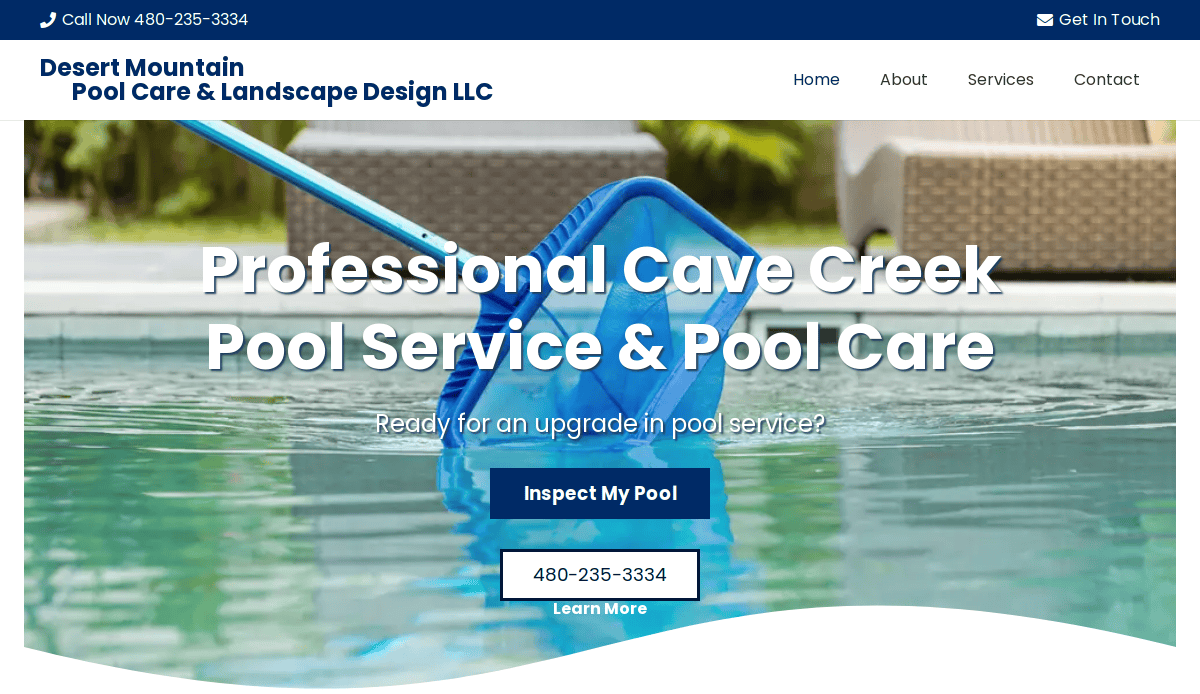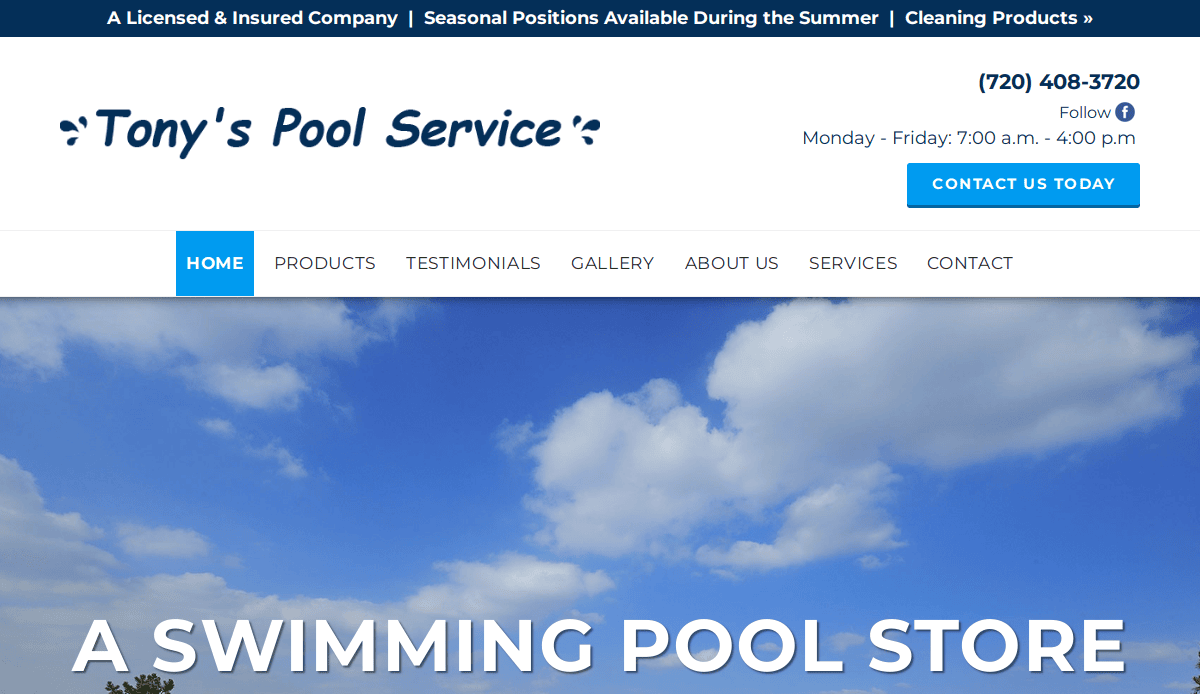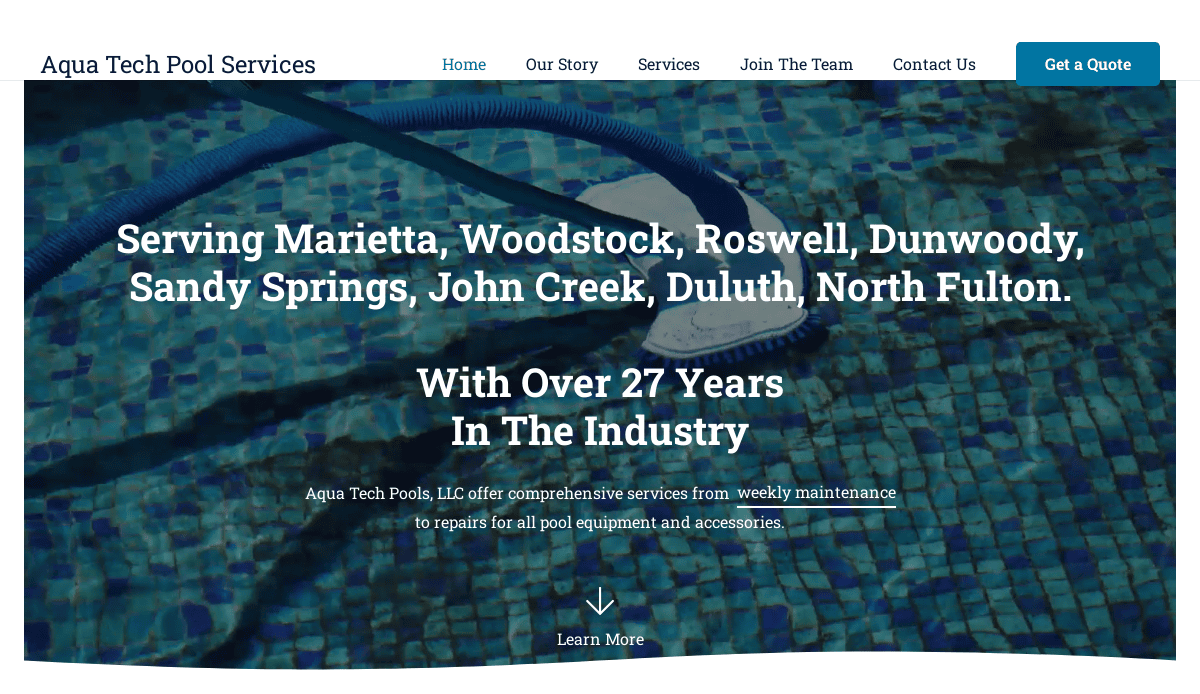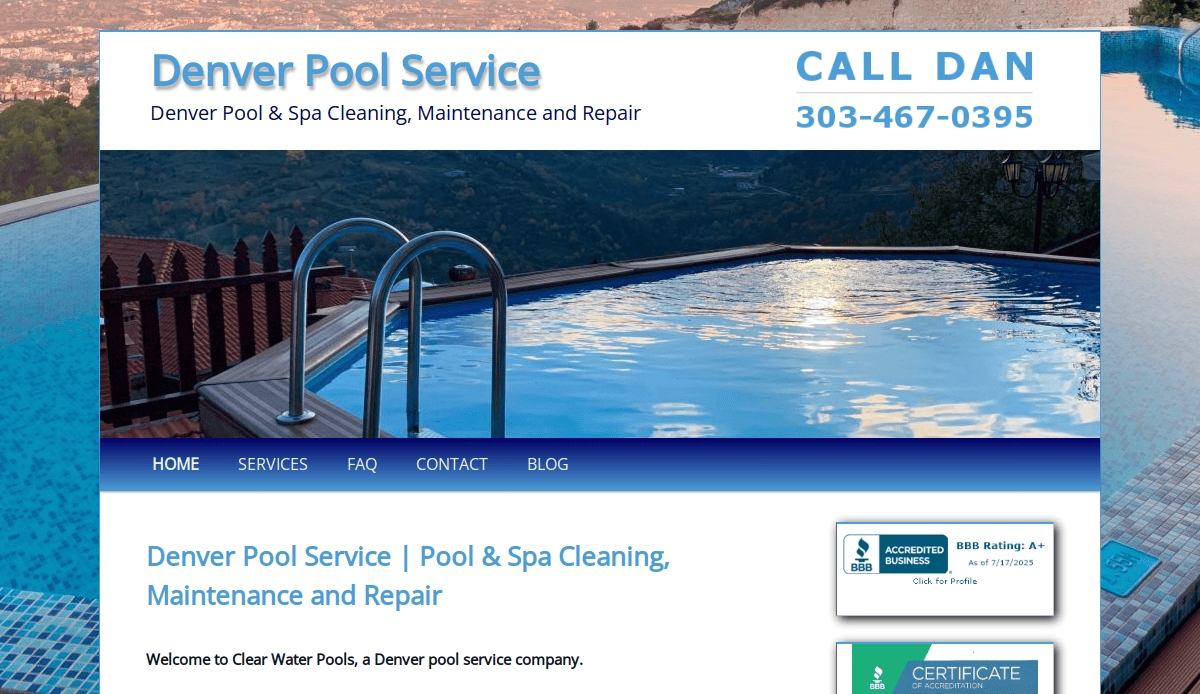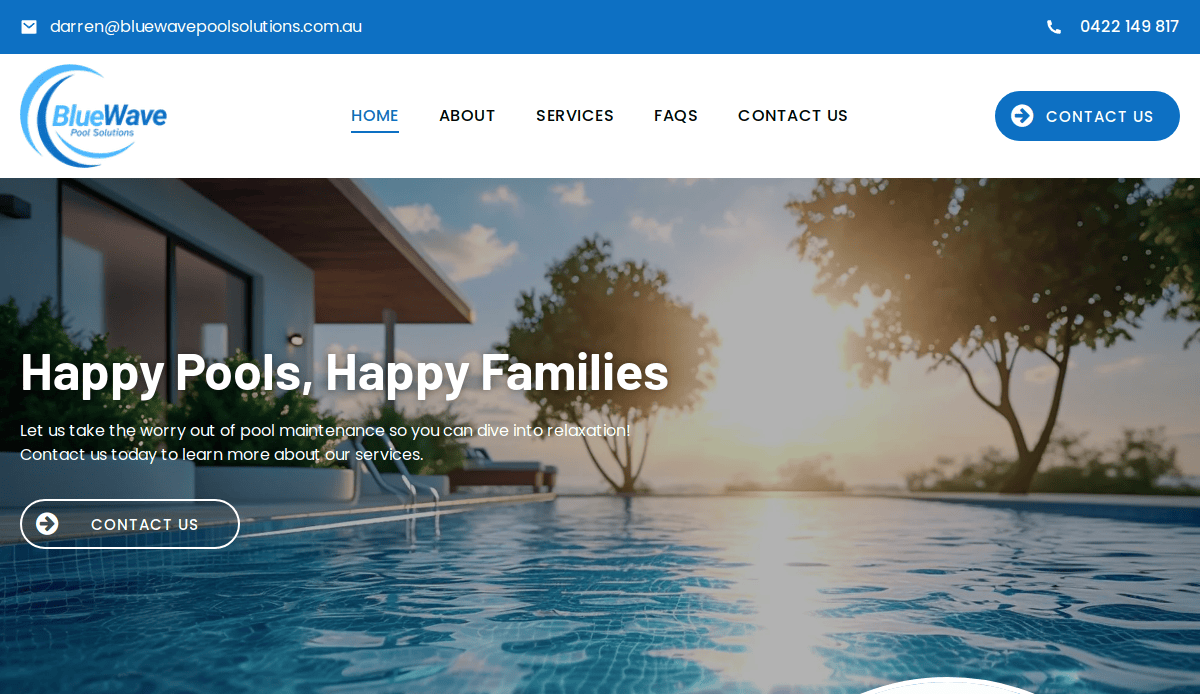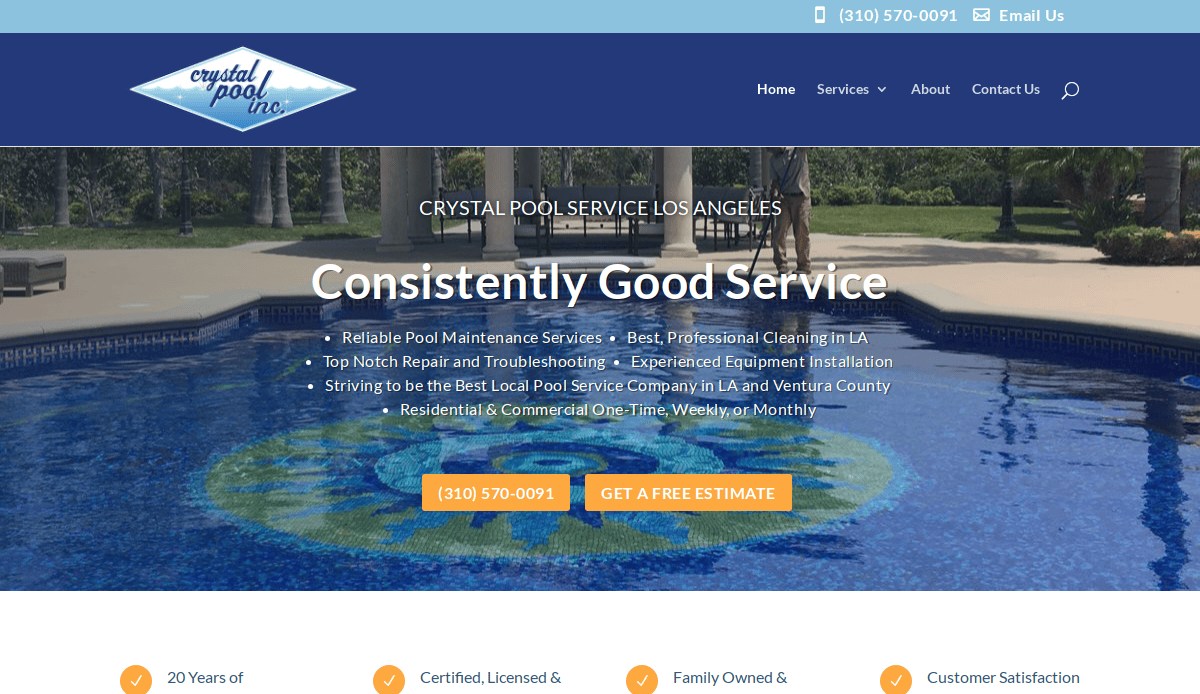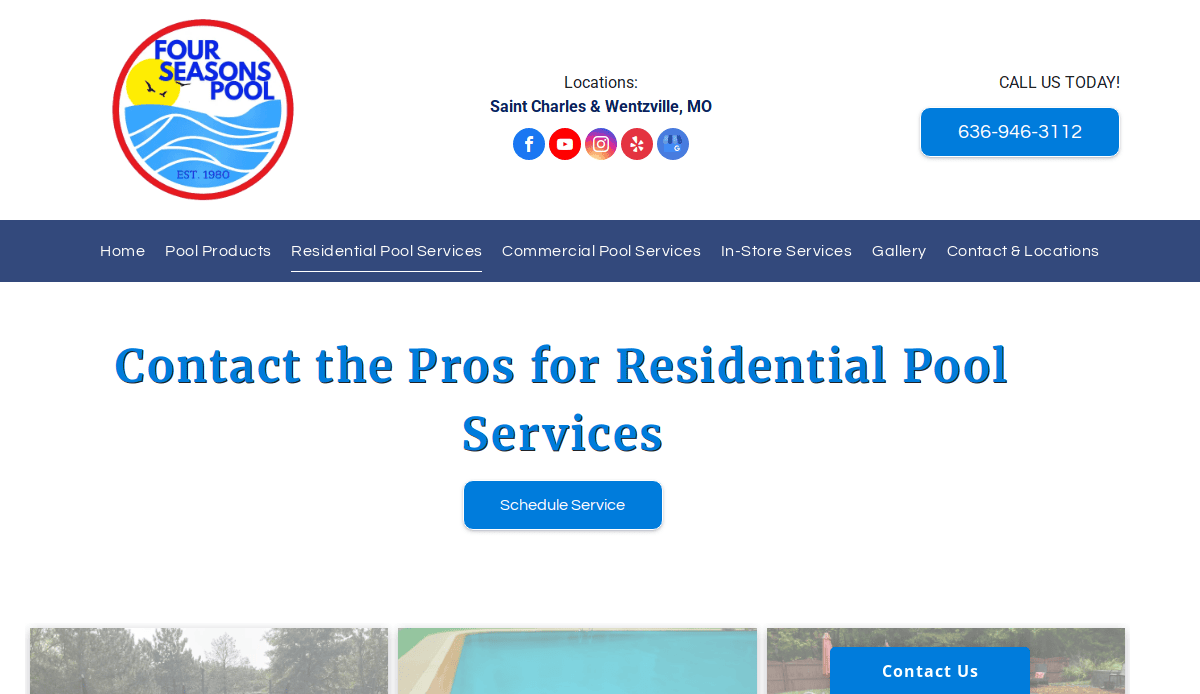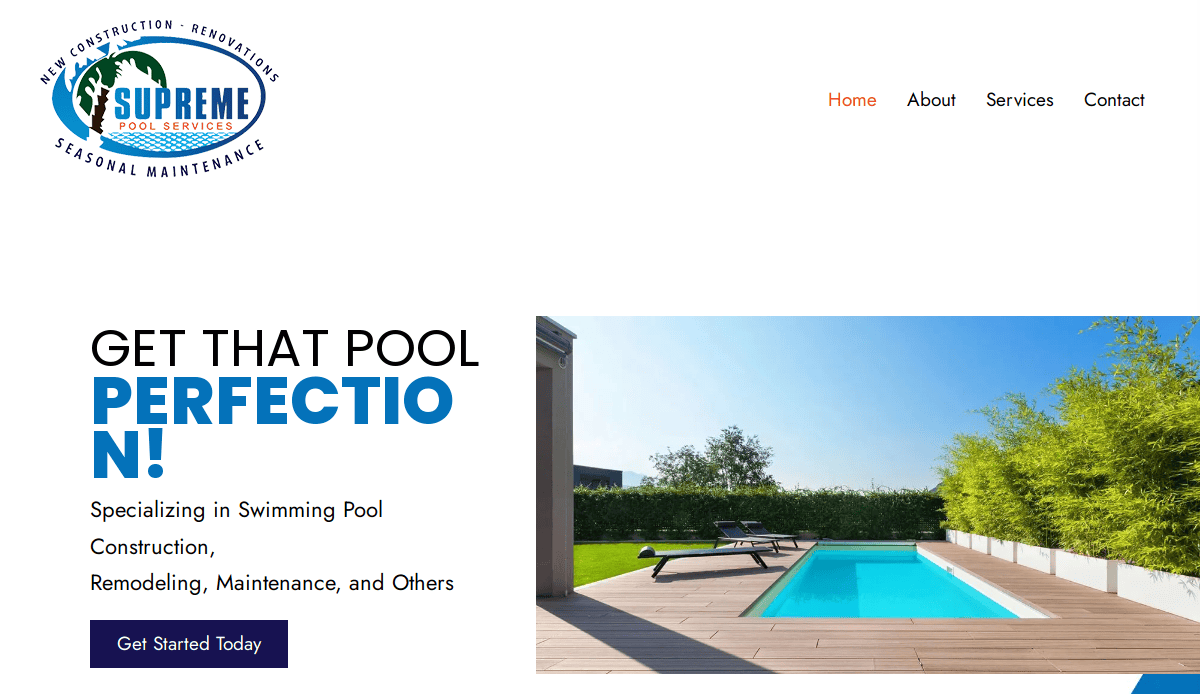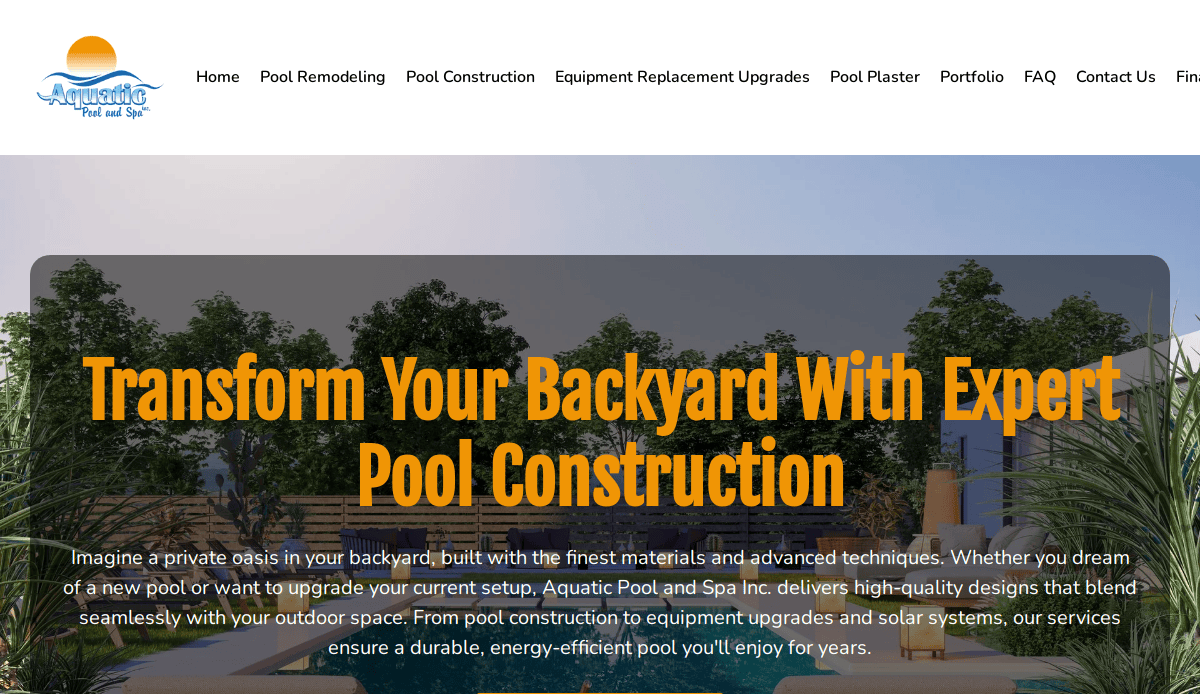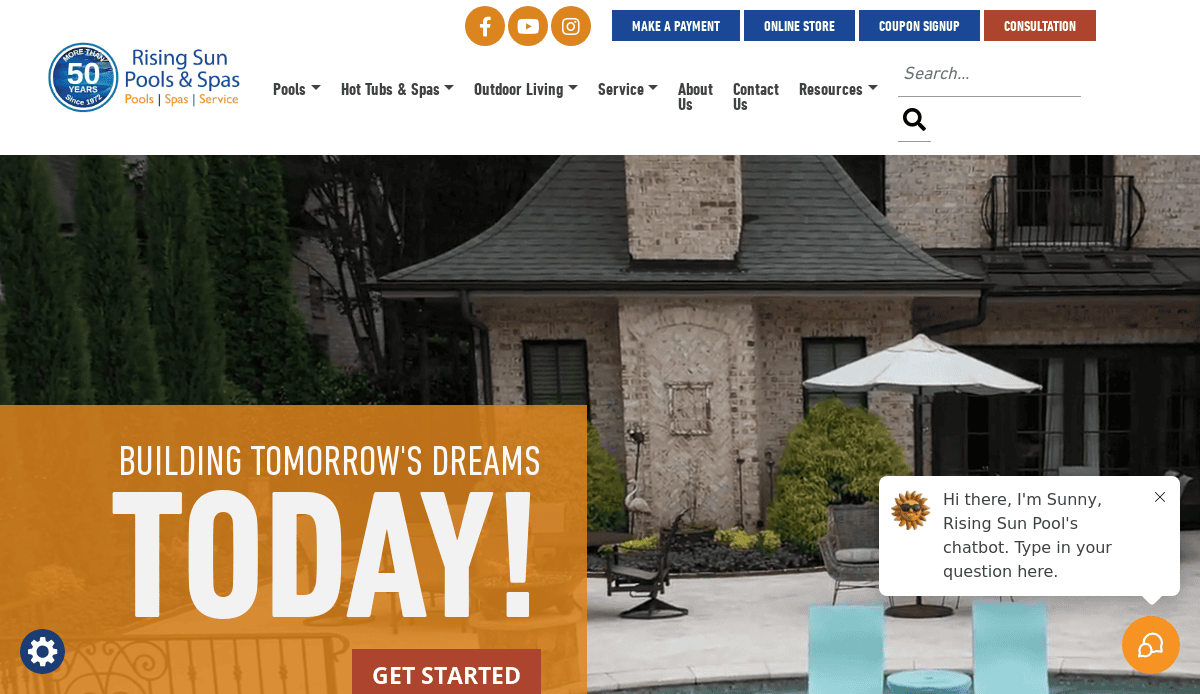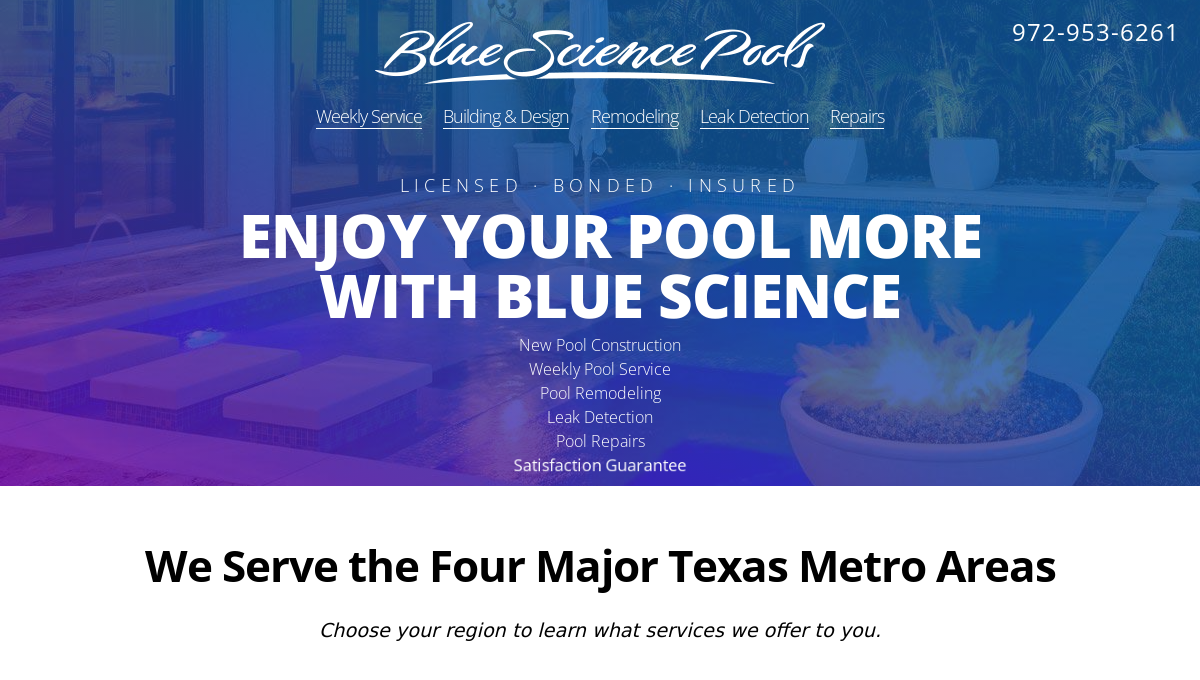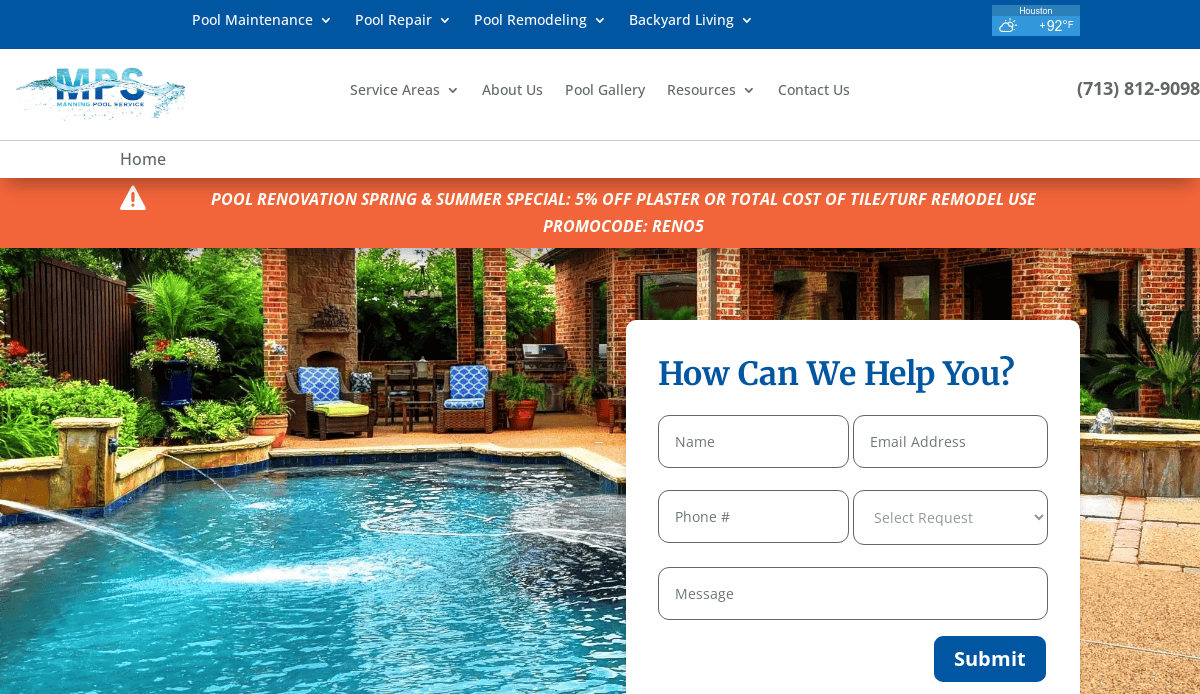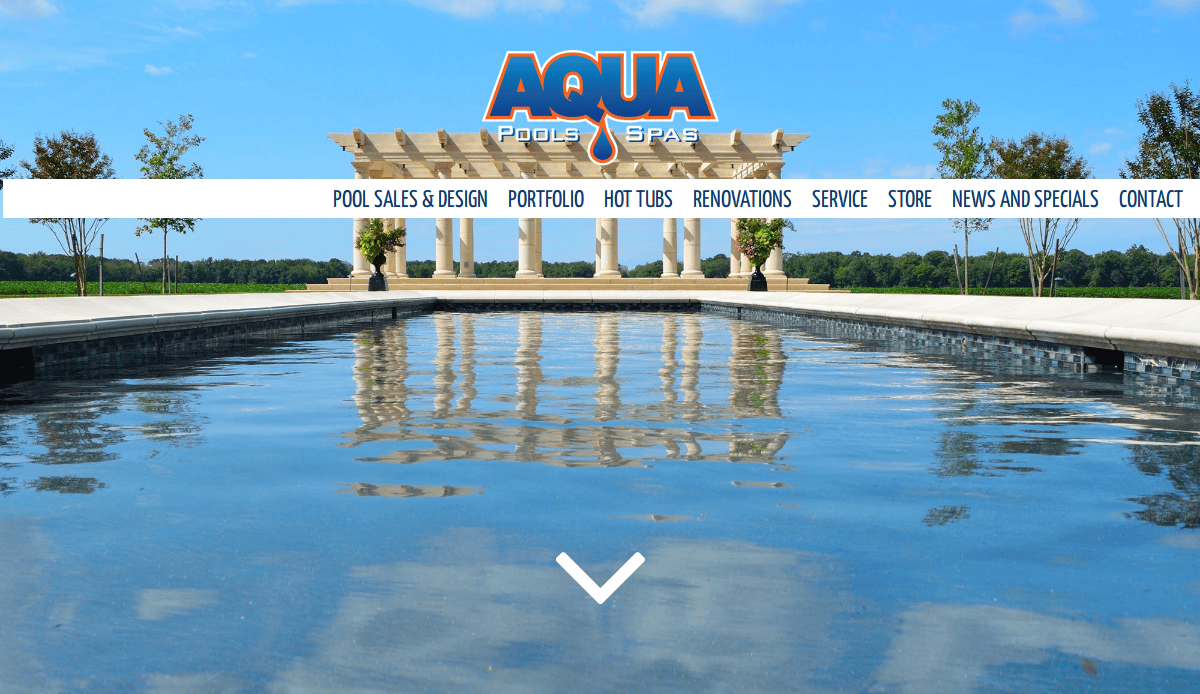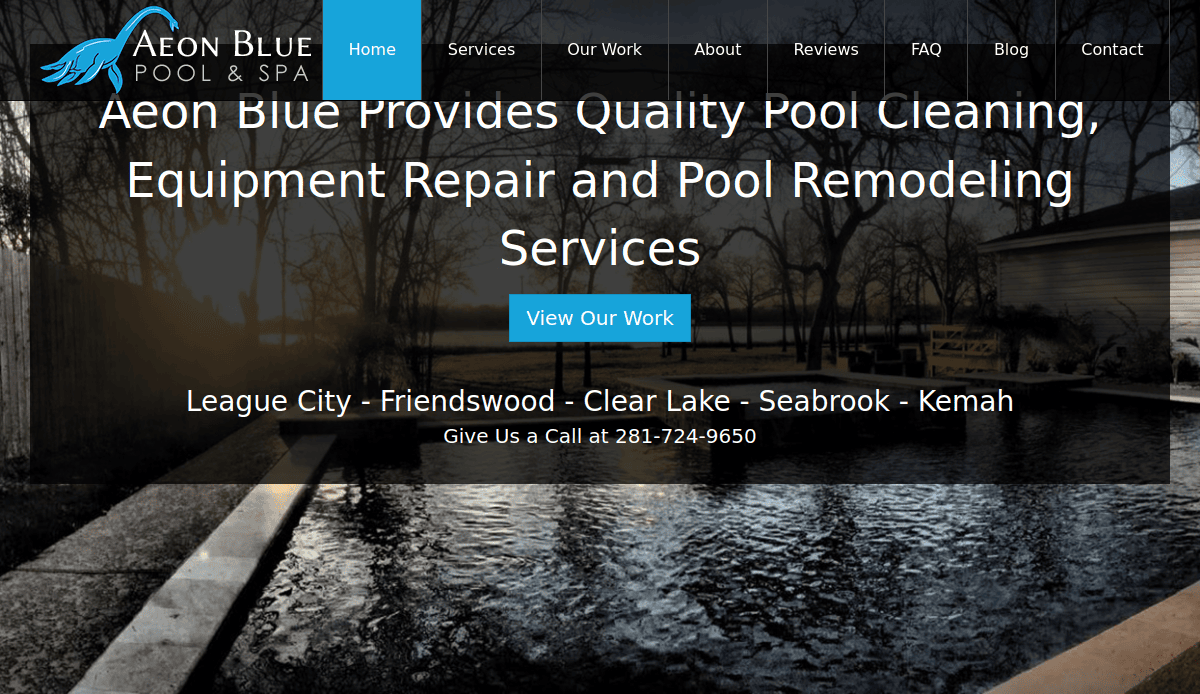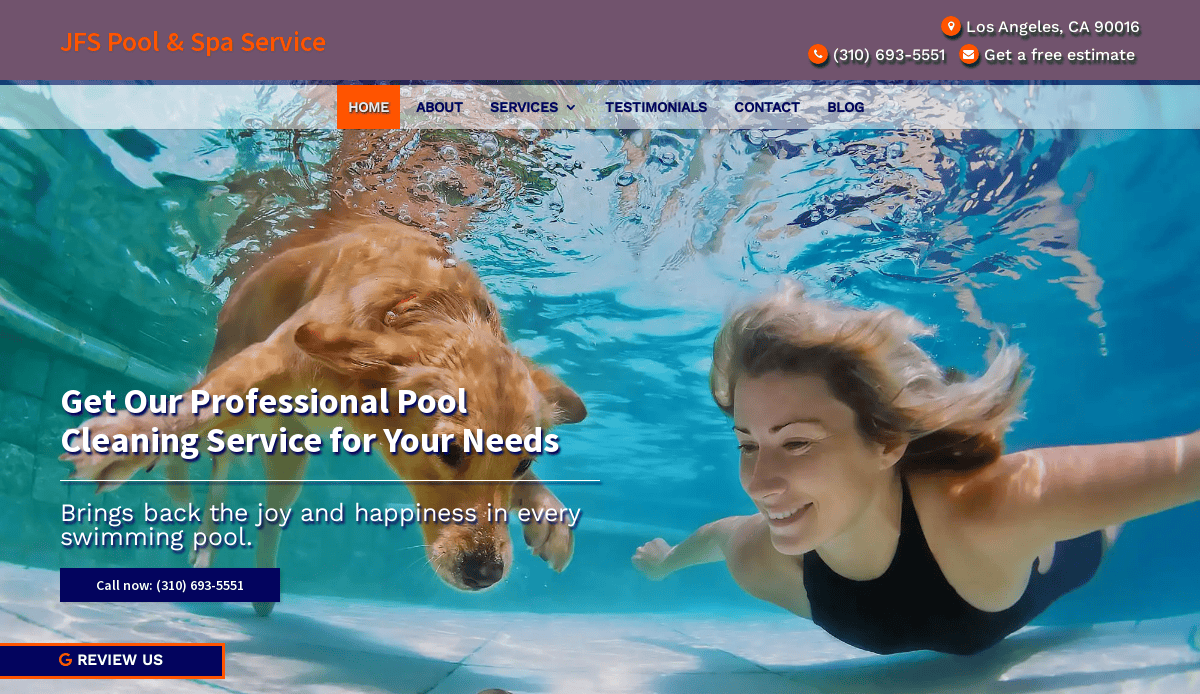Just looking for our Best Pool Cleaning Website examples list?
Designing a high-performing website for your swimming pool service business involves more than just aesthetics. It requires a strategic approach that combines user experience, functionality, and industry-specific insights.
Key Takeaways:
1. Prioritize Mobile Responsiveness and Fast Loading Times
With a significant portion of users accessing websites via mobile devices, ensuring your site is mobile-friendly is paramount. A responsive design that adapts seamlessly to various screen sizes enhances user experience and reduces bounce rates. Additionally, optimizing your website for fast loading times improves user satisfaction and positively impacts search engine rankings.
2. Showcase High-Quality Visual Content
Visuals play a crucial role in conveying the quality and scope of your services. Incorporate professional photographs of completed projects, before-and-after images, and possibly short videos demonstrating your services. This builds trust with potential customers and provides tangible proof of your expertise.
3. Implement Clear Calls-to-Action (CTAs)
Guide your website visitors towards desired actions by incorporating clear and compelling CTAs. Whether it’s scheduling a consultation, requesting a quote, or subscribing to a newsletter, strategically placed CTAs can significantly increase conversion rates. Ensure these prompts are easily visible and align with the user’s journey on your site.
4. Optimize for Local SEO
Enhancing your website’s visibility in local search results is essential for attracting nearby clients. Include location-specific keywords, register your business with local directories, and encourage satisfied customers to leave positive reviews. These practices improve your local search rankings and make it easier for potential clients in your area to find your services.
5. Provide Comprehensive Service Information
Clearly outline the range of services you offer, including detailed descriptions and any unique selling points. Transparency regarding pricing, service packages, and what clients can expect helps build trust and sets accurate expectations. Consider including an FAQ section to address common inquiries and reduce barriers to engagement.
By focusing on these key areas, your website can effectively attract, engage, and convert visitors into loyal clients. A well-designed website serves as a powerful tool in showcasing your expertise and growing your business in the competitive service industry.
Why Your Swimming Pool Business Deserves a High-Impact Website
A great website isn’t just a bonus for swimming pool businesses—it’s a necessity. Whether you specialize in cleaning, maintenance, or selling pool care equipment, your website is the face of your brand and the engine driving your lead generation. Yet, many service providers struggle with outdated designs that fail to reflect their professionalism or attract new clients.
Think of your website like a well-maintained pool filter—it works behind the scenes to keep your pool business running efficiently. When designed right, it does more than just look good. It educates owners on how to use your pool products properly, showcases your expertise in handling pool chemicals, and guides visitors to book your pool maintenance services with ease.
From helping clients vacuum their pool safely to teaching them how to shock their pool effectively, your website can be a powerful tool to deliver real value. If you sell robotic pool cleaners, offer tips to keep your pool clean, or provide emergency support when a pump fails, the right digital presence can differentiate your brand and drive conversions.
This guide is designed to show pool professionals how to turn a generic online presence into a high-performing website that drives results. We’ll cover modern design trends, SEO tips, and practical strategies to help you stand out, keep your pool care content organized, and create a seamless experience for your customers, whether they’re looking for pool accessories or searching for urgent advice on pool shock.
Let’s dive into what it takes to build a swimming pool website that doesn’t just float—it makes waves.
Website Planning & Purpose: Laying the Foundation for Success
Before choosing colors, crafting content, or uploading photos of crystal-clear pools, every successful website begins with a solid planning phase. This is where business goals are aligned with user needs to create a clear strategy that guides the entire design and development process.
1. Define the Primary Purpose of the Site
For most companies, the primary goal is to generate leads through quote requests, service calls, or contact form submissions. But depending on your specific offerings, your site may also serve to:
- Educate customers on pool maintenance, cleaning schedules, or how to properly shock the water
- Promote and sell pool care products like robotic pool cleaners, pumps, and chemicals
- Schedule on-site appointments for services like pool filter checks or water balancing
Clearly defining your top priorities ensures that every design decision—from layout to CTA placement—works toward those objectives.
2. Understand Your Target Audience
Are your ideal customers pool owners seeking weekly cleaning services? DIYers looking for advice on how to vacuum your pool or maintain pool water quality? Or busy families who want a service to keep their pool clean without hassle?
Defining your audience helps tailor messaging, images, and features to match their expectations. For example, homeowners in need of pool maintenance may respond better to straightforward service menus, while those interested in upgrading to a robotic cleaner may expect product comparison charts and educational content.
3. Map the User Journey
Once you understand who your audience is, map how they will interact with your site. Where will they land? What will they click next? What barriers could prevent them from requesting a quote? Strategic planning ensures your navigation, service pages, and CTAs are frictionless and intuitive.
4. Identify Key Features & Integrations
Planning also includes determining what technical features you’ll need to support your goals. For professional websites, that might include:
- Integrated booking or scheduling tools
- Chat features for quick customer inquiries
- Mobile-optimized galleries to display past work
- Educational blog sections for topics like pool shock or pool pump maintenance
- Secure forms to capture quote requests
Every feature should serve a clear function tied to conversion or client education.
5. Establish Content Priorities
The planning phase should also outline what content needs to be created or rewritten. Service descriptions, pricing breakdowns, FAQs, and maintenance tips like how to use a pool brush or balance pool chemicals all need to be clearly organized and SEO-optimized.
By laying this strategic groundwork before any design work begins, businesses can ensure their website isn’t just a digital brochure but a purpose-built tool that drives measurable business growth.
Design Principles: Creating a High-Converting Website
Effective design is more than visual appeal—it’s about functionality, clarity, and guiding users toward taking action. Where homeowners and commercial clients often land with specific needs, like scheduling a cleaning or understanding how to shock your pool, design principles must align with those expectations.
1. Visual Hierarchy That Guides the Eye
Visitors scan rather than read. A well-structured visual hierarchy uses size, contrast, and placement to direct attention where it matters most, such as service categories, call-to-action buttons, or key differentiators. For example, a clear “Request a Quote” button should stand out on every page, guiding owners to take the next step without confusion.
2. Consistent and Clean Branding
A cohesive visual identity builds trust. Use a consistent color palette that reflects water clarity, cleanliness, and professionalism—shades of blue, white, and gray often perform well in this industry. Use high-resolution imagery that complements your services, such as close-ups of a clean pool filter or a technician using a brush for the pool or robotic cleaner.
3. Mobile-First Design
Over 60% of web traffic comes from mobile devices. That means your website must be responsive, fast-loading, and easy to navigate with a thumb. Service buttons, phone numbers, and contact forms should all be usable from a smartphone without pinching or scrolling excessively.
4. Strategic Use of White Space
Crowded layouts create confusion and stress. White space (also known as negative space) helps break up content, improve readability, and draw attention to important elements. This is especially important for pool care service pages where users are looking for quick, scannable answers, like how to vacuum your pool or maintain proper pool water chemistry.
5. Accessible, Clear Navigation
Navigation should be intuitive, simple, and accessible. Limit menu items to essentials: Home, Services, About, Contact, Blog, and Reviews. Group services logically—pool maintenance, cleaning, equipment installation, water testing—and link each to relevant service pages.
6. Conversion-Driven Layout
Every page should be designed to drive action. Use section breaks, bold subheadings, and directional cues to lead users from pool maintenance information to service forms or product inquiries. For instance, after describing the benefits of pool shock treatment, include a prominent CTA like “Schedule Your Next Pool Shock Appointment.”
7. Trust Elements and Social Proof
Customer trust is vital. Design should incorporate reviews, testimonials, certifications, and before-and-after photos prominently throughout the site. Highlight client success stories, especially those involving challenges solved, like fixing a broken pool pump or restoring balance to chemically unstable pool water.
These design principles ensure that your website isn’t just a digital placeholder—it becomes a tool that supports your sales pipeline, enhances brand credibility, and keeps your business top-of-mind for every potential client.
Content & Navigation: Structuring for Clarity, SEO, and Conversions
A website’s content and navigation are just as critical as its visuals. Poor navigation leads to confusion; vague or generic content leaves users uninformed and unmotivated. To keep your site functional, engaging, and conversion-friendly, both structure and messaging must be deliberate.
1. Plan Your Core Pages Around User Intent
Your website should reflect how users think about your services, not how you internally categorize them. These are the non-negotiable core pages:
- Home – Summarizes services, emphasizes unique value, and leads visitors to deeper content.
- Pool Cleaning Services – Detail weekly, biweekly, or one-time cleaning with info on what’s included (e.g., vacuum your pool, brush steps, balance pool water).
- Maintenance & Repairs – Outline tasks such as checking the pump, replacing pool filters, or troubleshooting cloudy water.
- Pool Equipment Sales/Installations – Feature robotic cleaners, pumps, or filters. Include buying guides or comparisons if applicable.
- About Us – Build trust with your brand story, years in business, and team credentials.
- Contact – Prominent and frictionless, with a clear form and map if local service is offered.
2. Use Descriptive, SEO-Friendly Navigation Labels
Avoid generic menu items like “Services” or “Products” without context. Instead, use labels like “Pool Cleaning & Maintenance” or “Install a New Pool Pump.” These terms are clearer to users and more valuable for SEO.
3. Create a Logical Navigation Hierarchy
Organize top-level menu items to reflect priority services. Group subpages under these primary services, such as:
- Pool Maintenance
- Weekly Pool Care
- Pool Filter Cleaning
- Pool Shocking Services
- Pool Equipment
- Robotic Pool Cleaners
- Energy-Efficient Pumps
- Pool Water Testing Kits
This approach helps users locate what they need quickly, while also reinforcing topical authority for search engines.
4. Build Out FAQ and Educational Resources
Support conversion and SEO with a knowledge hub or blog. Answer common questions like:
- How often should you shock your pool?
- How do I choose the right robotic cleaning tools?
- Why is my pool water cloudy after rain?
Include internal links to relevant service pages to enhance user flow and on-site engagement.
5. Maintain Content Clarity with Scannable Formats
Pool owners often visit your site looking for fast answers. Use:
- Short paragraphs (1–2 sentences)
- Bullet points to explain service steps (e.g., brush, vacuum, chemical treatment)
- Subheadings with keywords (e.g., “Keep Your Pool Clean With Scheduled Maintenance”)
- Icons or images to support technical content
Avoid walls of text. Guide visitors with structure and clarity.
6. Always Prioritize Conversion Paths
Every piece of content should lead somewhere. After explaining how to use a brush correctly or when to replace a pool filter, direct the user to schedule a service or contact your team. Use consistent CTAs like “Get a Free Quote” or “Request Pool Service Today.”
When content and navigation are strategically aligned, your website becomes more than a brochure—it becomes a tool that educates, builds trust, and turns curious visitors into long-term clients.
Visual Elements: Enhancing Trust, Clarity, and Brand Identity
Visuals are often the first impression your website makes—and they can be the difference between a bounce and a conversion. Where cleanliness, clarity, and professionalism are essential, strong visual elements don’t just support the user experience—they define it.
1. Use High-Quality, Relevant Photography
Every image on your website should reinforce your brand’s professionalism and the quality of your services. Avoid stock photos that look overly generic or fake. Instead, use original photos of:
- Sparkling clean pools you’ve serviced
- Technicians in uniform brushing, testing, or vacuuming pools
- Close-ups of robotic cleaning equipment or pumps in use
- Hands applying pool shock or balancing pool chemicals
These visuals provide proof of service and help users envision what they can expect when hiring your team.
2. Incorporate Before-and-After Comparisons
One of the most powerful ways to build trust is by showing transformations. Before-and-after images of dirty pool water versus clean, or equipment upgrades like replacing an outdated filter with a high-efficiency pump system, help reinforce your expertise visually.
3. Design With Color Psychology in Mind
Professional websites should evoke feelings of cleanliness, safety, and relaxation. Color palettes that include clean whites, calming blues, and accents of aqua or light gray tend to work well. Avoid dark or harsh colors that may conflict with the idea of clarity and fresh water.
4. Integrate Icons to Support Quick Scanning
Icons help break up content and provide visual cues. They can be used to represent services such as:
- Pool cleaning (broom or vacuum symbol)
- Water testing (test tube)
- Pool repairs (wrench or gear)
- Pool filter replacements (filter icon)
This makes the content easier to digest and appeals to users skimming on mobile devices.
5. Embed Explainer Videos or Demonstrations
Short videos can clarify complex tasks like how to shock your pool, backwash a filter, or use your pool’s automation system. These videos position your business as both a service provider and a trusted authority. Make sure they are embedded with a fast-loading player and optimized for mobile.
6. Use Consistent Visual Branding Across the Site
Consistency in visuals—colors, photography style, icon sets, button shapes—builds familiarity and professionalism. This is especially important for businesses offering both residential and commercial services. Your visuals should reflect that you’re equipped to handle both scopes without confusion.
7. Prioritize Speed and Optimization
All visual elements must be optimized for performance. Large image files or videos that load slowly can degrade user experience and hurt search rankings. Compress images, use modern file formats like WebP, and implement lazy loading for media elements.
Visual elements are more than decorative—they are strategic tools that establish trust, convey professionalism, and make your services tangible. For pool businesses, leveraging clean, purpose-driven visuals turns a good website into a great one.
Ongoing WordPress Maintenance: Keeping Your Site Running Smoothly
A well-built WordPress website for your business isn’t set-it-and-forget-it. Just like regular pool maintenance is necessary to keep your pool water clean and safe, your website requires consistent care to stay secure, functional, and optimized.
1. Security Updates to Protect Your Business
WordPress powers over 40% of the web, making it a common target for hackers. Routine updates to WordPress core, plugins, and themes are critical to close vulnerabilities that could expose your site to malware or data breaches. Failing to maintain these can result in service outages or damaged customer trust.
2. Performance Checks and Speed Optimization
Slow websites drive away potential clients. Ongoing maintenance includes regular performance audits, database cleanups, and caching improvements to ensure your site loads quickly on all devices. Fast load times are especially important for mobile users trying to request cleaning services while on the go.
3. Plugin and Theme Management
Plugins extend your website’s functionality, but outdated or incompatible ones can break site features. Monthly checks ensure that everything—from your appointment scheduling tools to your interactive pool maintenance FAQs—continues to operate as expected.
4. Backup and Recovery Systems
Unexpected issues like hosting failures, plugin conflicts, or human error can crash your site. Scheduled backups provide peace of mind, ensuring you can quickly restore functionality without losing critical data or disrupting service requests.
5. SEO and Content Optimization Reviews
Search engines favor websites that are updated and relevant. Regular maintenance includes checking for broken links, refreshing service descriptions, and updating blog content that explains how to shock your pool, maintain pool pumps, or compare robotic cleaners.
6. Form and Functionality Testing
Every few weeks, test all forms, CTA buttons, and interactive tools to confirm they’re still working properly. This ensures a customer trying to schedule a pool filter replacement or request pricing for pool water treatment isn’t met with frustration or error messages.
7. Compliance with Evolving Web Standards
Keeping your website compliant with ADA accessibility standards and privacy laws such as GDPR or CCPA isn’t optional. Routine updates ensure you’re following best practices and protecting your business from potential legal issues.
A website that is professionally maintained communicates reliability, which builds client confidence. Ongoing WordPress maintenance is not a backend chore—it’s a core function of delivering a smooth, secure experience to every person who visits your site.
20 Professional Pool Site Examples
1. Desert Mountain Pool Service
Location: Scottsdale, AZKey
Takeaways:
- Clean, user-friendly design with intuitive layout.
- High-quality photographs showcasing services.
- Clear calls to action highlighting expertise.
2. Tony’s Pool and Spa Services
Location: Austin, TXKey
Takeaways:
- Convenient online platform for personalized cost estimates.
- Well-organized layout for easy navigation.
- Comprehensive service information.
3. AquaTech Pool Services
Location: Miami, FL
Key Takeaways:
- Modern design with responsive features.
- Detailed service descriptions with educational content.
- Strong branding and visual consistency.
4. ClearWater Pool Maintenance
Location: Denver, CO
Key Takeaways:
- Emphasis on eco-friendly services.
- Interactive scheduling and service request forms.
- Testimonials highlighting customer satisfaction.
5. BlueWave Pool Solutions
Location: San Diego, CA
Key Takeaways:
- Vibrant visuals showcasing pool transformations.
- Easy-to-navigate service categories.
- Blog section with pool care tips and advice.
6. Crystal Pool Service
Location: Los Angeles, CA
Key Takeaways:
- Comprehensive listing of services and benefits.
- Prominent contact information and calls to action.
- Clear presentation of service areas.
7. 4Seasons Pool Service
Location: St. Charles, MO
Key Takeaways:
- Sticky navigation bar for easy access.
- Visible phone number and call to action.
- Engaging images against a clean background.
8. Payan Pool Service
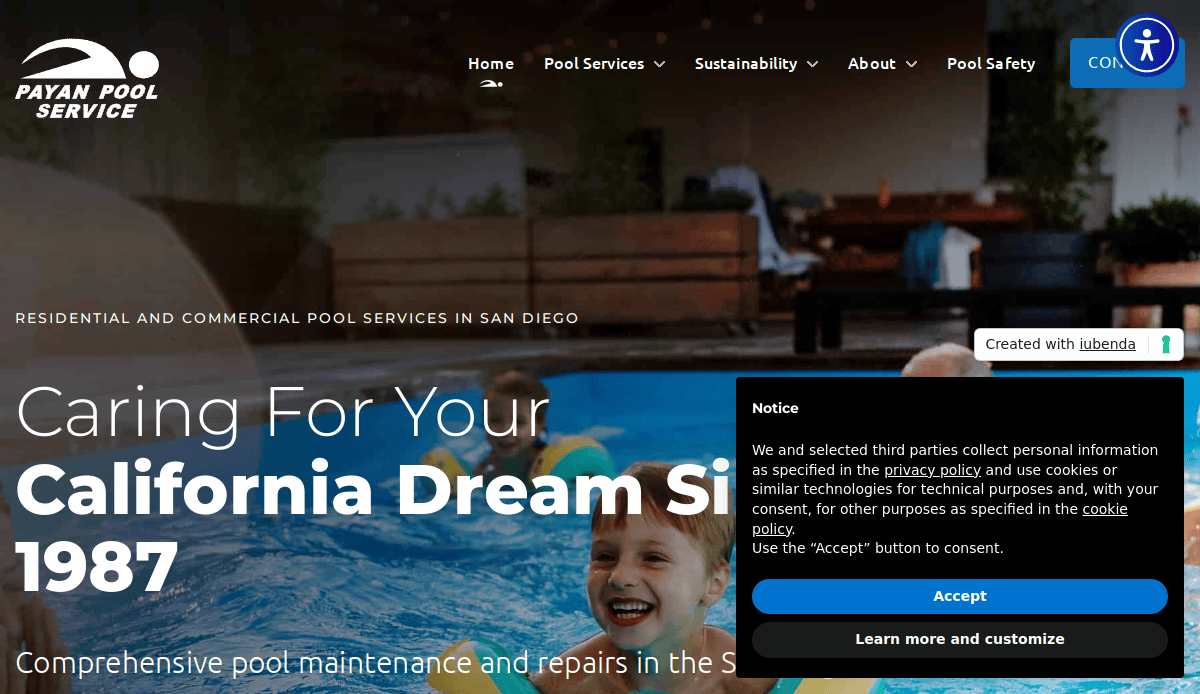
Location: Phoenix, AZ
Key Takeaways:
- Sophisticated color scheme with clean design.
- Organized service outlines with images and links.
- Sticky navigation for user convenience.
9. Supreme Pool Service
Location: Houston, TX
Key Takeaways:
- Prominent display of motto and contact information.
- Detailed information on products and services.
- Pleasing pool images enhance visual appeal.
10. Aquatic Pool & Spa Service
Location: Orlando, FL
Key Takeaways:
- Modern design with heavy use of video and images.
- Organized content with consistent branding.
- Clear calls to action throughout the site.
11. Forever Blue Pools
Location: San Antonio, TX
Key Takeaways:
- Veteran-owned business highlighted prominently.
- Informative specials and promotions.
- Text broken up with images and headers for readability.
12. Rising Sun Pools
Location: Raleigh, NCKey Takeaways:
- Clear call to action at the top of the page.
- Informative text accompanied by images.
- Organized service and product information.
13. Blue Science Pools
Location: Dallas, TX
Key Takeaways:
- Multiple service areas clearly listed.
- Easy navigation to pick a service area or read more.
- Customer reviews are available for visitors.
14. Premier Pool Cleaning
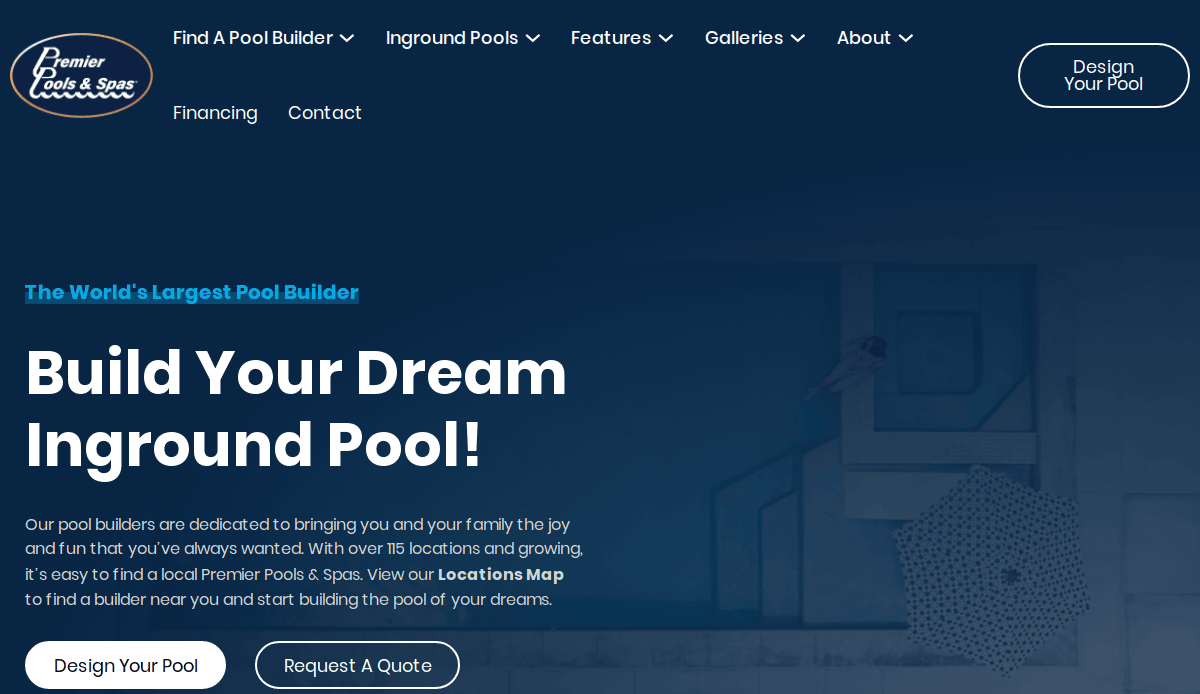 Location: Jacksonville, FL
Location: Jacksonville, FL
Key Takeaways:
- Simple design consistent with branding.
- Detailed explanations of services offered.
- Educational blog posts for visitors.
15. J’s Pools & Spas
Location: Atlanta, GA
Key Takeaways:
- Elegant design with a consistent color scheme.
- Sticky navigation bar for ease of use.
- Attractive images complement the text.
16. Manning Pool Service
Location: Seattle, WA
Key Takeaways:
- Visible call to action at the top of the page.
- Online form for easy communication.
- Informative content about the company
17. Aqua Spas and Pools
Location: Easton, MD
Key Takeaways:
- Engaging header image slider.
- Detailed company and service information.
- Balanced use of text and images.
18. Aeon Blue Pool & Spa
Location: San Francisco, CA
Key Takeaways:
- Clear navigation and service area information.
- Customer reviews and latest news sections.
- Consistent branding throughout the site.
19. Brown’s Pools & Spas
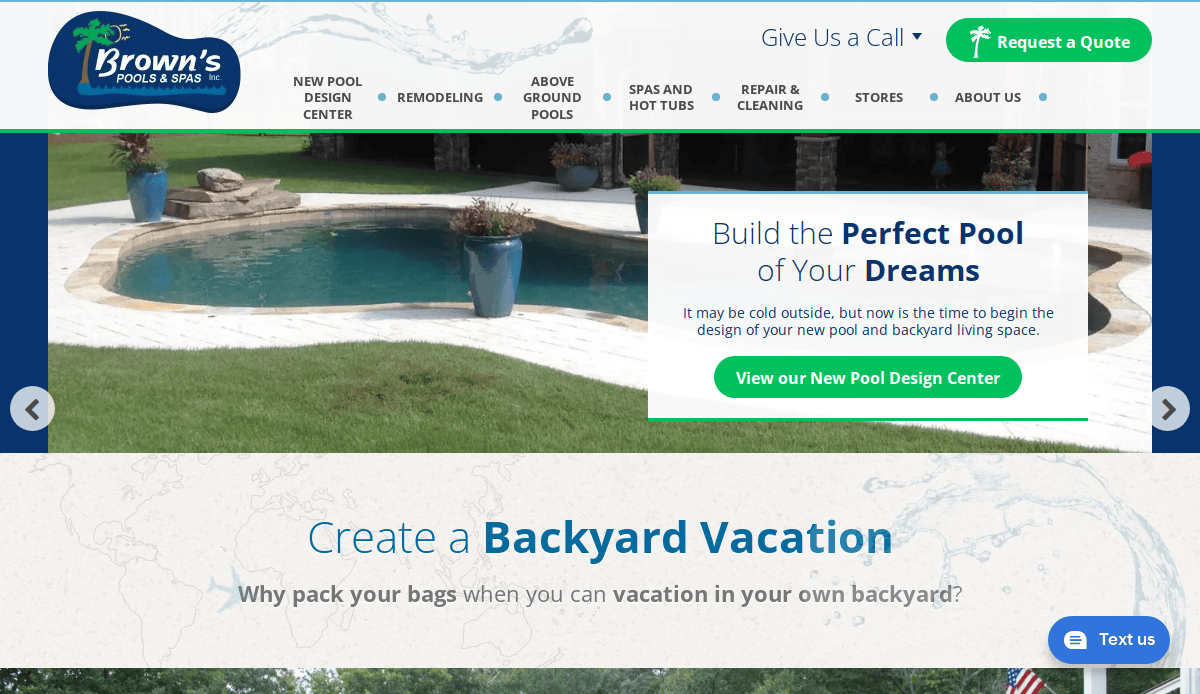 Location: Nashville, TN
Location: Nashville, TN
Key Takeaways:
- Simple design highlighting offerings.
- Prominent contact information.
- Easy booking and service information access.
20. JFS Pool & Spa Service
Location: Charlotte, NC
Key Takeaways:
- Customized design fitting company branding.
- Multiple calls to action without overwhelming the visitor.
- Highlighted services with clear information.
Take Action: Build a Website That Reflects Your Expertise in Pool Care
If you’re serious about growing your company, your website should work as hard as you do. This guide to pool service website design has outlined everything you need—from the essentials of pool maintenance scheduling to how your online presence should reflect your expert offerings.
Remember, your site is more than just a marketing tool—it represents your authority in swimming pool care, your understanding of pool chemistry, and your ability to maintain a pool to the highest standards. Whether you’re educating visitors on how to sanitize your pool, explaining how a pool heater or pool pump, and filter work, or showing customers how to vacuum your pool weekly to ensure your pool stays clean, your site should be built with these real needs in mind.
You already know the basics: run your pool pump daily, shock it once every week, and maintain pool circulation to help keep your pool clean and safe to swim. Now it’s time to translate that same level of attention into your online presence with a professional website built to reflect your authority.
Whether your audience needs a guide to DIY pool care, cleaning cheat sheets, or a step-by-step guide on how to clean your pool from the bottom of your pool to the surface, your website should showcase your expertise with clarity and confidence.
Make sure your business stands out — get a custom website strategy from CyberOptik today to help keep your pool business running smoothly, and your digital presence just as polished as your next clean pool.
Smart Answers for Pool Service Website Success (FAQs)
What should be on a website for my pool company?
Your website should include clear service descriptions, a contact page, trust-building visuals, and educational content on pool care basics. Including blog posts on topics like water care, how to vacuum the bottom of the pool, or understanding pool automation can help establish authority. An internal step-by-step guide to the web design process can help you plan your content architecture.
How can a website help educate new pool owners?
A good industry website should include a guide to pool maintenance, care cheat sheets, and blog posts that break down components of a swimming pool. This helps new owners understand how to keep their pool safe and what regular care routines they should follow.
What keywords should I target on my pool and spa business website?
Focus on terms such as owning a swimming pool, care of your pool, cloudy pool water, automatic pool cleaner, and ways to sanitize your pool. Incorporate these naturally into your service pages, blog posts, and FAQs. Use a keyword strategy that reflects your services and includes semantic variations like pool water quickly and safely to swim.
What visual features should be included on a service website?
Use high-quality photos showing the bottom of the pool being cleaned, pool and spa service technicians at work, and close-ups of components like filters or vacuums. Diagrams showing basic components of a swimming pool or how pool automation works can also boost engagement and retention.
Can my website explain how different pool systems work?
Yes. Your site can be an educational resource explaining how each tool works, from the pump to the filter to the heater. Detail how water from the pool circulates, how vacuuming affects clarity, and how to keep it running smoothly throughout the year.
Should I offer guides on my website?
Absolutely. Offering an ultimate guide to care or a basic pool maintenance checklist builds credibility and encourages repeat visits. If you’re targeting local customers, location-specific tips like “How to maintain your Dallas pool during peak summer” can drive more traffic.
How do I optimize my site for local search visibility?
Use location-based keywords like Dallas pool services or pool cleaning in [Your City]. Add testimonials from local clients and write content about how to keep your pool safe in your local climate. Local SEO also includes optimizing your Google Business Profile and embedding maps on your contact page.
Why does content matter for professional websites?
Content that addresses what people need to know about pool systems—such as the best way to clean the pool at night, how to keep your pool looking great, or choosing the right pool components—helps with SEO and builds trust. Focus on detailed, actionable content that resonates with both new and experienced owners.
What if I offer a variety of services?
Group your content by service type—cleaning, repairs, automation, installations—and ensure each has its own landing page. Explain how your services keep the pool clear, safe to swim, and optimized for enjoying it in every season. Use visuals and bullet lists to break down services for easier reading.
What if I’m just starting my service business website?
Start by organizing your message. Use beginner-friendly content and ensure the site explains basic care principles. Leverage resources like our design guide and include blog posts that introduce people to the care for your pool and how to run your pool effectively. Clear, structured content will help your business scale and your website convert.

